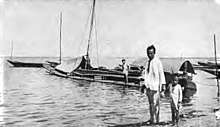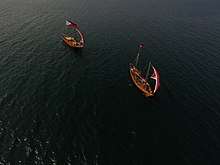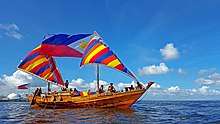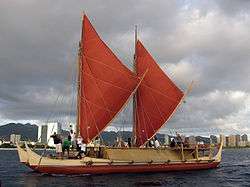Balangay
Balangay, also spelled barangay, balanghai is a type of lashed-lug boat built by joining planks edge-to-edge using pins, dowels, and fiber lashings. They are found throughout the Philippines and were used largely as trading ships up until the colonial era. The oldest known balangay are the Butuan boats, which have been carbon-dated to 320 AD and were recovered from several sites in Butuan, Agusan del Norte.[1]


Balangay were the first wooden watercraft excavated in Southeast Asia. Balangay are celebrated annually in the Balanghai Festival of Butuan City.[2]
Names
Balangay was one of the first native words the Europeans learned in the Philippines. When Antonio Pigafetta went ashore to parley with the ruler of Mazua, they sat together in a boat drawn up on shore which Pigafetta called a balangai. This word appears as either "balangay" or "barangay", with the same meaning, in all the major languages of the Philippines.[3]
The term was also used by the Tagalog people to refer to the smallest discrete political units, which came to be the term used for native villages under the Spanish colonial period.[3][4][5] The name of the boat was usually Hispanicized in Spanish and American records as barangayan (plural: barangayanes) to distinguish them from the political unit.[6][7][8]
Among the Ibanag people of Northern Luzon, balangay were known as barangay, a term sometimes extended to the crew. Large vessels were called biray or biwong.[3]
In the Visayas and Mindanao, there are multiple names for balangay-type boats, including bidok, biroko, baloto (not to be confused with the balutu), baroto, biray, or lapid.[3]
History

.jpg)
In the province of Cagayan in Northern Luzon, balangay were mainly used as cargo and fishing ships by the Ibanag people. They were predominantly used within the Cagayan River system, but were also sometimes used as coastal trade ships, reaching as far as the Ilocos Region.[3]
In Tagalog regions, the balangay or barangay differs from Visayan balangay in that it is constructed through the sewn-plank technique, rather than through dowels.[9]
In the Visayas and Mindanao islands, balangay were primarily inter-island trading ships, cargo transports, and warships. Large balangay (especially warships), including the Butuan boats, are commonly equipped with large double-outriggers which support paddling and fighting platforms, in which case, they can be generically referred to as paraw.[3][9][10] Balangay warships, along with the larger karakoa, were regularly used for raiding (mangayaw) by Visayan warriors. It is believed that they may have been the "Pi-sho-ye" raiders described as regularly attacking Chinese settlements in the coast of Fujian in the 12th century AD.[11]
Marina Sutil

During the 18th to 19th centuries, balangay were also often used as warships for defending coastal villages from Moro and Dutch raiders during the Moro Wars, in conjunction with watchtowers (castillo, baluarte, or bantay) and other fortifications. The raiders were regularly attacking coastal settlements in Spanish-controlled areas and carrying off inhabitants to be sold as slaves in markets as far as Batavia and the Sultanate of Gowa. Defense fleets of balangay and vinta (known as the Marina Sutil, "Light Navy" or "Defense Navy") were first organized under Governor-General José Basco y Vargas in 1778. They were lightly armed but fast, which made them ideal for responding quickly to raider sightings and attacks.[7][12][13][14]
Notable leaders of these defense squadrons include Don Pedro Estevan, a principal of Tabaco, Albay; and Julian Bermejo, an Augustinian friar who commanded ten balangay and established an alarm system using a line of small forts in southern Cebu. They were responsible for several major naval victories against Moro raiders from the late 18th to the early 19th centuries. The most significant was the Battle of Tabogon Bay (modern Tabgon, Caramoan) in 1818, where the combined fleets of Estevan and Don Jose Blanco defeated around forty Moro warships led by Prince Nune, the son of a sultan from Mindanao. Nune escaped, but hundreds of Moro raiders died in the sea battle and around a thousand more were stranded and hunted down in the mountains of Caramoan. The 1818 victory led to increased usage of defense fleets and the reduction of Moro raids to only sporadic attacks on isolated fishermen or smaller villages until their eventual suppression in 1896.[7][12][13][14]
Construction
Balangay were the first wooden watercraft excavated in Southeast Asia.[15][3] Balangay were basically lashed-lug plank boats put together by joining the carved out planks edge to edge, using pins or dowels. The planks, which were made from a hardwood called doongon in the Philippines (Heritiera littoralis), were fastened together every 12 centimetres, also by hardwood pin measuring some 19 centimetres long, which were driven into holes on the edge of each plank. On the inner side of the boat the planks were provided, at regular intervals, with raised rectangular lugs, carved from the same plank, through which holes were bored diagonally from the sides to the surface.[16]
Rib like structures made of lengths of wood were then lashed against these lugs to provide a flexible bulkhead, to reinforce and literally sew the boat together. Cordage known as cabo negro (Arenga pinnata) was used for the purpose. The hull, measuring about 15 meters long and 4 meters wide, was ordinarily semicircular in cross section and with no marked keel. Provided with huge outriggers, the boat was propelled either by a sail or by paddling.[16]
The boats were finely manufactured without any blueprints and were taught to be made from one generation to another and uses a technique still used by boat makers of Sibutu Island in the Southern Philippines.[16]
Butuan Boats

Since the 10th century, Butuan appeared to have been in good relations with the Srivijaya. Being located on the coast of Mindanao, balangays were often docking at Butuan bay keeping good business between the local people of Butuan and traders from the neighboring empire and neighboring islands.[2][17] Various goods, extending to the statue of Avalokiteśvara and the Golden Tara of Butuan, were traded across Maritime Southeast Asia.
The balangay boats were discovered in the late 1970s in Butuan City, Agusan del Norte. A total of nine wooden boats were accidentally found by locals searching for alluvial gold on land near the Masao River.[18] The site was in Sitio Ambangan, Barrio Libertad within an older dried-up river channel, perhaps a former tributary of the Masao River.[19]
Three of the nine balangays discovered have been excavated by the National Museum and are currently preserved. The first balangay or Butuan Boat One, was discovered in 1976 and is now displayed in Balangay Shrine Museum in Libertad, Butuan City. It was radiocarbon tested and was dated to 320 CE. The Butuan Boat Two was dated to 1250 CE, and is now located at the Maritime Hall of the National Museum in Manila.[18] The Butuan Boat Five, excavated at Bancasi, Libertad in 1986,[20] has been dated to 1215 CE and was transferred to the Butuan Regional Museum and is undergoing preservation.[18] The six other boats, which are yet to be excavated, remain in their original waterlogged condition which is proven to be the best way to preserve the said artifacts.[17]
In 2012, National Museum archaeologists discovered what seems to be a massive balangay "mother boat", estimated to be 25 meters long, versus the average 15-meter length of the other balangays at the excavation site. The leader of the research team, Dr. Mary Jane Louise A. Bolunia, reported the treenails or wooden pegs that were used in the construction of the mother boat to be around 5 centimeters in diameter.[21] As of June 2013, excavations of the find are still ongoing.
The first wooden watercraft excavated in Southeast Asia, the balangay is only found in the Philippines where a flotilla of such prehistoric wooden boats exists.[22] Nine specimens were discovered in 1976 in Butuan, Agusan Del Norte, Mindanao, and 3 have already been excavated.
Declarations
National Cultural Treasures
The balangays of Butuan was declared by President Corazon Aquino as National Cultural Treasures by virtue of Presidential Proclamation No. 86 on 9 March 1987 and the vicinity of excavation as archaeological reserves.[22]
National Boat
In November 2015, the Balangay was declared as the National Boat of the Philippines by the House Committee on Revisions of Laws. The Balangay was chosen so that the "future generations of Filipinos will recognize the invaluable contribution of their forefathers in shaping the country's maritime tradition and in passing on the values of solidarity, harmony, determination, courage and bravery.[1][27]
House Bill 6366 declares the Balangay as the National Boat of the Philippines.[28]
The Balangay Voyage
In 2009, the Kaya ng Pinoy Inc. that conquered Mt. Everest in 2006 announced plans to re-construct a balangay boat, with the help of Sama-Bajau (Sama Dilaya) and other tribal members who retained the lashed-lug boat-building techniques which were mostly lost in other islands. The balangay's voyage traced the routes of the Filipino Ancestors during the waves of Austronesian settlement through Maritime Southeast Asia and the Pacific.[29][30] The special wood for construction came from the established traditional source in southern Philippines, specifically Tawi-Tawi. The team have pinpointed Sama-Bajau master boat builders, whose predecessors actually built such boats, and used traditional tools during the construction. The balangay was constructed at Manila Bay, at the Cultural Center of the Philippines Complex.[31][32]
The Balangays, named Diwata ng Lahi, Masawa Hong Butuan, and Sama Tawi-Tawi,[33] navigated without the use of modern instruments, and only through the skills and traditional methods of the Filipino Sama people. They Journeyed from Manila Bay to the southern tip of Sulu, stopping off at numerous Philippine cities along the way to promote the project. The journey around the Philippine islands covered a distance of 2,108 nautical miles or 3,908 kilometers.[31][34]
The second leg of the voyage (2010-2011) saw the balangay boats navigate around South East Asia - Brunei, Indonesia, Malaysia, Singapore, Cambodia, Thailand and up to the territorial waters of Vietnam before heading back to the Philippines.[31][34]

The balangay was navigated by the old method used by the ancient mariners – steering by the sun, the stars, the wind, cloud formations, wave patterns and bird migrations. Valdez and his team relied on the natural navigational instincts of the Badjao. Apart from the Badjao, Ivatan are also experts in using the boat.[31][34][35] The organisers say that the voyage "aims to bring us back to the greatness of our ancestors and how colonialism robbed these away from us and produced the Filipino today".[36][37]
In 2019, the Balangay Voyage team announced two more balangay (Lahi ng Maharlika and Sultan sin Sulu) will set sail in 14 December 2019 from Palawan to Butuan, then to Mactan to commemorate the 500th anniversary of the Battle of Mactan. The two boats will be temporarily renamed Raya Kolambu and Raya Siyagu.[38]
Balangay Site Museum
The Balangay Site Museum also known as "Balanghai Shrine Museum" houses the balangays excavated on 320 AD.[39] It is located at Sitio Ambangan, Barangay Libertad, Butuan City. It also displays the cultural materials such as human and animal remains, hunting goods, jewelries, coffins, pots and other items associated to the boat.[40] The establishment of the shrine in 1979 was made possible by the donation of land from Felix A. Luna, a resident of the area.
Balanghai Festival
In Butuan, Agusan del Norte, the annual Balanghai Festival celebrates the settlement of Butuan via the balangay ships.[41]
References
- "Balangay declared PH National Boat". Archived from the original on 2015-12-08.
- BALANGHAI FESTIVAL - Commemorating the coming of the early settlers from Borneo and Celebes
- Barangay by William Henry Scott
- Zaide, Sonia M. (1999). The Philippines: A Unique Nation. All-Nations Publishing. pp. 62, 420. ISBN 971-642-071-4. citing Plasencia, Fray Juan de (1589). Customs of the Tagalogs. Nagcarlin, Laguna.
- Junker, Laura Lee (2000). Raiding, Trading, and Feasting: The Political Economy of Philippine Chiefdoms. Ateneo de Manila University Press. pp. 74, 130. ISBN 971-550-347-0.
- Mallat, Jean (1983). The Philippines: History, Geography, Customs, Agriculture, Industry, and Commerce of the Spanish Colonies in Oceania. National Historical Institute. pp. 45–46.
- Montero y Vidal, José (1894). Historia general de Filipinas desde el descubrimiento de dichas islas hasta nuestras días. 2. Est. Tip. de la Viuda e Hijos de Tello. pp. 395, 408, 505, 506, 620.
- An official guide to eastern Asia. 5. Tetsudōshō (鉄道省). 1920. p. 76.
- Scott, William Henry (1982). "Boat-building and seamanship in classic Philippne society" (PDF). Philippine Studies. 30 (3): 335–376.
- Stead, Martin Roderick (2018). Defining the Construction Characteristics of Indigenous Boats of the Philippines: The Impact of Technical Change Pre and Post Colonisation (PDF) (MPhil). University of Southampton.
- Isorena, Efren B. (2004). "The Visayan Raiders of the China Coast, 1174-1190 AD". Philippine Quarterly of Culture and Society. 32 (2): 73–95.
- Warren, James Francis (2002). Iranun and Balangingi: globalization, maritime raiding and the birth of ethnicity. NUS Press. p. 109. ISBN 9789971692421.
- Mallari, Francisco (1986). "Muslim Raids in Bicol, 1580-1792". Philippine Studies. 34 (3): 257–286. JSTOR 42632949.
- Dery, Luis C. (1989). "The era of the kris: Moro raids in Sorsogon and Kabikolan and their impact on Philippine History, 1571-1896" (PDF). Transactions National Academy of Science. 11: 145–166.
- Hontiveros, G. 2014. Balangay: Re-launching an Ancient Discovery
- Hontiveros, G. 2004 Butuan of a Thousand Years.
- "Replica of 'balangay' embarks on epic voyage". ABS-CBN Corporation; Agence France-Presse. 2009-09-27. Retrieved 2009-10-01.
- Clark, Paul; Green, Jeremy; Santiago, Rey; Vosmer, Tom (1993). "The Butuan Two boat known as a balangay in the National Museum, Manila, Philippines". The International Journal of Nautical Archaeology. 22 (2): 143–159. doi:10.1111/j.1095-9270.1993.tb00403.x.
- "Butuan: The First Kingdom." Butuan City Historical and Cultural Foundation, 1990.
- Alvares, Mauro; Clark, Paul; Green, Jeremy; Santiago, Rey; Vosmer, Tom. "Interim report on the joint Australian–Philippines Butuan boat project, October 1992". ResearchGate. Retrieved 9 December 2015.
- Dimacali, Timothy James M. (9 August 2013). "Massive balangay 'mother boat' unearthed in Butuan". GMA News Online. Retrieved 31 August 2013.
- "Agusan solon files heritage bill anew; seeks to declare Balangay as 'National Boat'". 14 August 2014. Archived from the original on 29 November 2014. Retrieved 4 September 2014.
- Change Me Into A Chieftain: Resistance and Persistence in Upland Panay Island, Philippines, D. Gowey, Arizona State University
- "Ethnographic Reading of Silungan Baltapa: Ancestral Tradition and Sufic Islam Values of Sama Bajau". 2013-10-21.
- "Top 10 Legendary & Accursed Mythical Items in Philippine Lore • THE ASWANG PROJECT". May 9, 2018.
- "Maria Cacao | Inquirer Opinion".
- "House Committee of Laws declares Balangay as National Boat". Retrieved 1 December 2015.
- "Committee Report 978" (PDF). Archived from the original (PDF) on 4 February 2016. Retrieved 4 February 2016.
- "Art Valdez rebuilds the ancient Balangay and sets it for voyage". Ferdziview. 5 June 2009. Retrieved 12 February 2020.
- The Balangay: Maritime Connectivity and Migration
- Evangelista, Katherine (2009-09-25). "Sailing around RP in an ancient 'balangay'". Philippine Daily Inquirer. Archived from the original on 2009-11-04. Retrieved 2009-10-01.
- "Brace for 'Balangay's epic voyage". Business Mirror. 2009-07-14. Archived from the original on 19 July 2009. Retrieved 2009-10-01.
- "'DIWATA NG LAHI' Finally Arrives in Butuan." City Government of Butuan. www.butuan.gov.ph. n.d. Web. 13 Dec. 2014.
- Ann Corvera (7 June 2009). "The Voyage of the Balangay: From the Mountain to the Seas". The Philippine Star.
- Sarmiento Jr., Juan V. (2009-09-27). "Building a Balangay". Philippine Daily Inquirer. Archived from the original on 2009-07-02. Retrieved 2009-10-01.
- "What the voyage hopes to achieve".
- "Balangay replica swamped by flood in Cavite". ABS-CBN Corporation News. 2009-09-09. Retrieved 2009-10-01.
- "Butuan's ancient Balangay boat replicas sail to start 500-day countdown to Mactan quincentennial celebrations". Good News Pilipinas. 8 November 2019. Retrieved 13 November 2019.
- "PARADISE ISLAND BARANGAY LIBERTAD". Butuan: LAGsik NA DAkbayan. 2016.
- Maranga, Mark (June 16, 2011). "Balangay Site Museum". Philippines Tour Guide.
- "Balanghai festival in Butuan City". Manila Bulletin. Retrieved 10 January 2020.
Further reading
- Quintos, Paul. "Balangay." 101 Filipino Icons. Manila: Adarna House, Inc. and Bench, 2007.
- Casal, Gabriel S., et al. "The Ingenious Filipino Boat." Kasaysayan Volume II: The Earliest Filipinos. Philippines: Asia Publishing Company Limited, 1998.
- archaeology. (accessed on 10 August 2007).
- The Philippine Consulate General – Vancouver, British Columbia Canada. (accessed on 10 August 2007).
- The Indigenous Filipino Boat


.jpg)